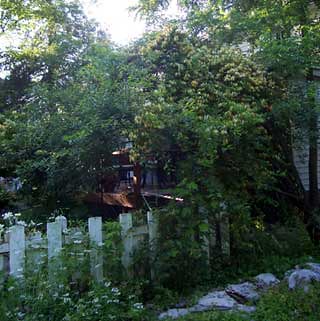Welcome to the Dark Side: Japanese Honeysuckle
 On summer afternoons when I was a child, I subsisted on little more than clover, sunshine and honeysuckle (and a few PB&J sandwiches).
On summer afternoons when I was a child, I subsisted on little more than clover, sunshine and honeysuckle (and a few PB&J sandwiches).
Like wrecking machine bees, the neighborhood kids and I could pillage a whole honeysuckle vine in just a few minutes, ripping the blooms off the plant in order to suck down the teeny drop of sweet nectar that was hidden at the base of the throat of the flower. And people wonder why I don’t let my kids into my flower beds.
Now, I am all grown up and I have come to realize that these honeysuckle have more to offer than a quick candy substitute. They also smell just luscious and look nice too. I have also found out that what I called honeysuckle or wild honeysuckle as a kid is actually called Japanese Honeysuckle.
Oh, but Japanese Honeysuckle has a Dark Side, Luke. It is an escaped invasive immigrant that has been sneaking through the woodlands of the East Coast, South and Midwest for more than 2 centuries, leaving a wake of destruction in its path. Japanese Honeysuckle is a twisting creeper and will lull you into a false sense of security right before it strangles your favorite tree or shrub. All the while looking beautiful and innocent, albeit massive.
There is where the problem is. An unchecked Japanese Honeysuckle vine can grow to cover an entire shrub in just a few short growing seasons. If it doesn’t kill the plant with its strangle-hold vines, its dense foliage will block the sun and eventually kill the plant beneath through lack of sunlight.
But the Dark Side beckons. The leaves of the Japanese Honeysuckle are thick and lush and mostly evergreen (unless you live somewhere very cold) and the flowers release a heady scent that can fill an entire garden. What do you do when the Japanese Honeysuckle’s victim is not quite as beautiful as its murdering guest?
I guess you let the Dark Side win and let the Japanese Honeysuckle grow and kill again.
And so it is in my neighbor’s yard. The tree in the picture is hers and sits smack dab on the property line between our yards. As yet another piece of “borrowed scenery“, I get to enjoy the scent and presence of the Japanese Honeysuckle that now covers more than half the tree.
There is no doubt that the tree beneath is dying. The leaves of the host tree are non-existent beneath the Japanese Honeysuckle and many of the tree’s branches are brittle and dead.
But the Japanese honeysuckle is so pretty and smells so nice… Welcome to the Dark Side.

I’m doing this project about the Japanese Honeysuckle. Do you no how it came to invade america?